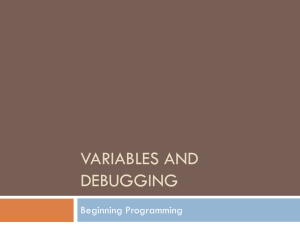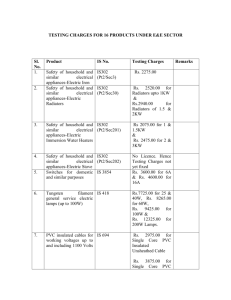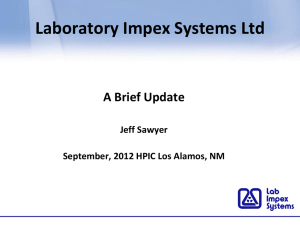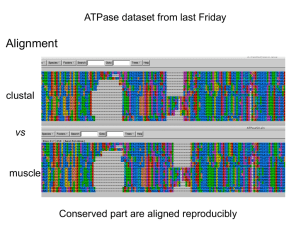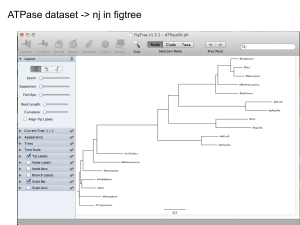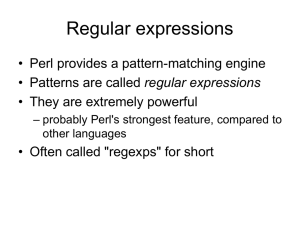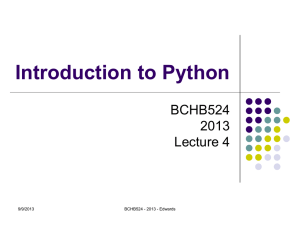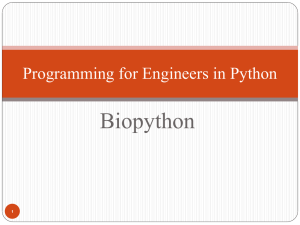Presentation - WordPress.com
advertisement
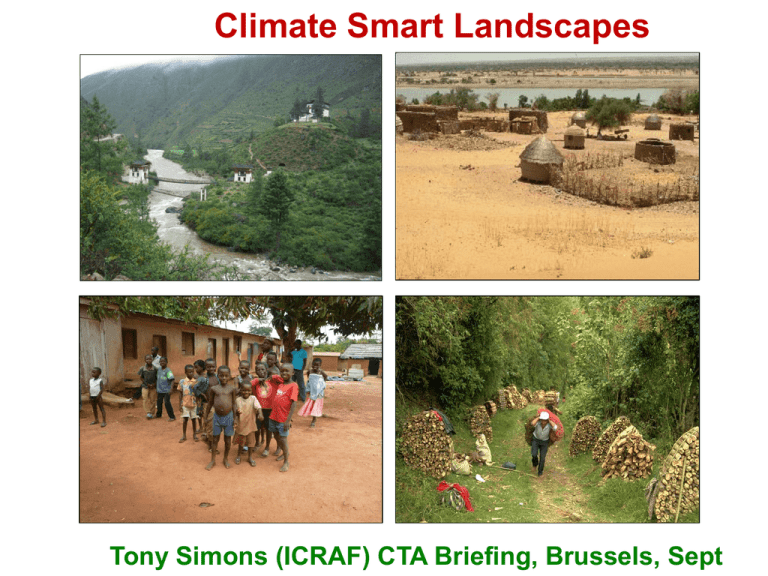
Climate Smart Landscapes Tony Simons (ICRAF) CTA Briefing, Brussels, Sept Climate Smart Landscapes 1. What is a Landscape? 2. Climate Smart (Wins and Losses) • The Landscape Approach 1. What is a Landscape? Landscape comprises the visible features of an area of land, including: •physical elements of landforms such as mountains, water bodies, vegetation •human elements including different forms of land use, buildings and structures, and •transitory elements such as weather conditions. (from Wikipedia, 2012) "landscapes are not only what lies before our eyes but what lies within our heads.“ (Mein Global Land Area Crop Land Pasture & Rangelands Crop Land Pasture & Rangelands 1.5 billion ha 3.4 billion ha 1.5 billion ha 3.4 billion ha Tree Plantations Natural Forest 0.3 billion ha 4.1 billion ha Natural Forest 4.1 billion ha Deserts Wetlands 1.9 billionUrban ha 1.3 billion ha Areas Deserts Wetlands 1.9 billion ha 1.3 billion ha Global Land Area - proportional Crop Land Pasture & Rangelands 1.5 billion ha 3.4 billion ha Natural Forest 4.1 billion ha Deserts Wetlands 1.9 billion ha 1.3 billion ha What is best way to achieve CSA •Productivity/Income •Sequestration/Mitigation •Reduced emissions •Resilience/Adaptation Agriculture Forestry Environment CSA REDD+ PES 2. Climate Smart (Wins, Losses) Climate Smart Agriculture seeks to: - Increase productivity/income (P&I) - Increase Carbon sequestration (Seq) - Reduce agriculture GHG emissions (REm) - Strengthen farmers’ resilience/adaptation (Adp) win-win-win-win? or tradeoffs? √√√ √ Win Four Wins P&I/Seq/REm/Ad p Three Wins P&I/Seq/REm Adp P&I/Seq/Adp REm P&I/REm/Adp Seq Seq/REm/Adp P&I P&I/Seq REm/Adp P&I/REm Seq/Adp P&I/Adp Seq/REm Seq/REm P&I/Adp Seq/Adp P&I/REm REm/Adp P&I/Seq P&I Seq/REm/Adp Seq P&I/REm/Adp REm P&I/Seq/Adp Adp P&I/Seq/REm Two wins ??? One win X XXX Lose No wins P&I/Seq/REm/Ad Zero grazing of ruminants Fertilised maize on poor soils IAASTD Rubber plantation in Amazon Tradeoffs between water & land productivity in drylands Information and Knowledge Gaps/Needs - Conceptual framework - Data sources - Modelling - M&E systems - Trade-off analyses (method and units) - Indicators, Metrics and Indices - Decision processes, choices, perspectives 3. The Landscape Approach 3. The Landscape Approach (cont.) - Much mentioned at Rio +20, why? - Is it new? Or a recycled existing approach? - Is it exclusive? - Championed by some with almost religious zeal - Will it apply in all locations? and all sectors? - Is it associated with an institution? - Does it have a formal definition? 3. The Landscape Approach (cont.) Four underlying Principles: 1. Make sense and operate across nested and interacting social and political scales (village, district, country) 2. Make sense and operate across nested and overlapping biophysical scales (e.g. farm, watershed, basin) 3. Involve multiple and defined sectors and stakeholders 4. Seek synergies and reduce tradeoffs People-Place-Purpose The right practice for the right people in the right place for the right Ethiopia soil map Soil maps generally static Coarse resolution Don’t reflect functional properties of the soil But what does it mean? and how can we use it? Soil Carbon (30m x 30m) Can guide better decisions Soil Erosion prevalence Landscape learnings from Challenges of 1. Market alone won’t solve deforestation problem REDD 2. • • • • • • • • • • • • • • Carbon only part of picture (water, habitat, biodiversity, services) MRV needs to be independent of government Handling cross-sectoral/ministerial issues Controversy over rights to pollute, displacement of emissions Opportunism of carbon cowboys Definition and inclusion problems of tree, forest Asynchronous forest laws, agrarian reform, land tenure Land-use/land-cover conundrum Bundling protection forest, production forest, conversion forest, (non REDD is only partial accounting Low capacity/compliance of fpic, indigenous rights, social safeguards Baselines versus reference levels Emissions embedded in trade Stock:emission rate ratios are lowering (time pressure to act) All actors believe most finance should go to them eastern western Fort Tenan FAO MICCA Project Using and Improving Predictive Tools for Potential Impact Participatory Assessment of Current and Potential Climate Smart Practices Increasing Productivity Awareness Raising, Capacity Development and Demonstratio ns Reducing Environmental Footprint Baseline Measurement and Monitoring of Land Health Greenhouse Gases Introduction or testing of Climate Smart Practices Tenure effects on land productivity and investment Adjudicated under the Land Adjudication Act CAP 284 1968, intensive smallholder cultivation with clear freehold title Un-adjudicated land: no firm legal title Norton-Griffith, in preparation Investment and returns to land Human Landscapes Land units as non-interacting aggregates Economic or social synergies not accommodated Social processes across land uses ignored or aggregated (Ghazoul, ISPC Meeting, 2011) The Good News …and yes, there are some systems that can give the four wins unsustainable agriculture climate smart landscapes
